Level 3 Access to HE: Understanding Health and Wellbeing Report
VerifiedAdded on 2023/01/16
|9
|2388
|24
Report
AI Summary
This report provides a comprehensive overview of health and wellbeing, addressing key aspects as outlined in the assignment brief. It begins by defining health according to the World Health Organization and then compares and evaluates the medical and holistic models, highlighting their strengths and weaknesses. The report distinguishes between global and international health, as well as morbidity and mortality. It delves into the determinants of health, including social, economic, physical, and genetic factors, and evaluates behavioral and biomedical risk factors. Furthermore, the report explores ways to mitigate these risk factors, providing practical strategies for promoting health. The discussion extends to theories of wellbeing, contrasting subjectivism and objectivism, and examines methods to enhance physical and psychological wellbeing. The conclusion emphasizes the importance of individual actions and environmental factors in achieving optimal health and wellbeing.
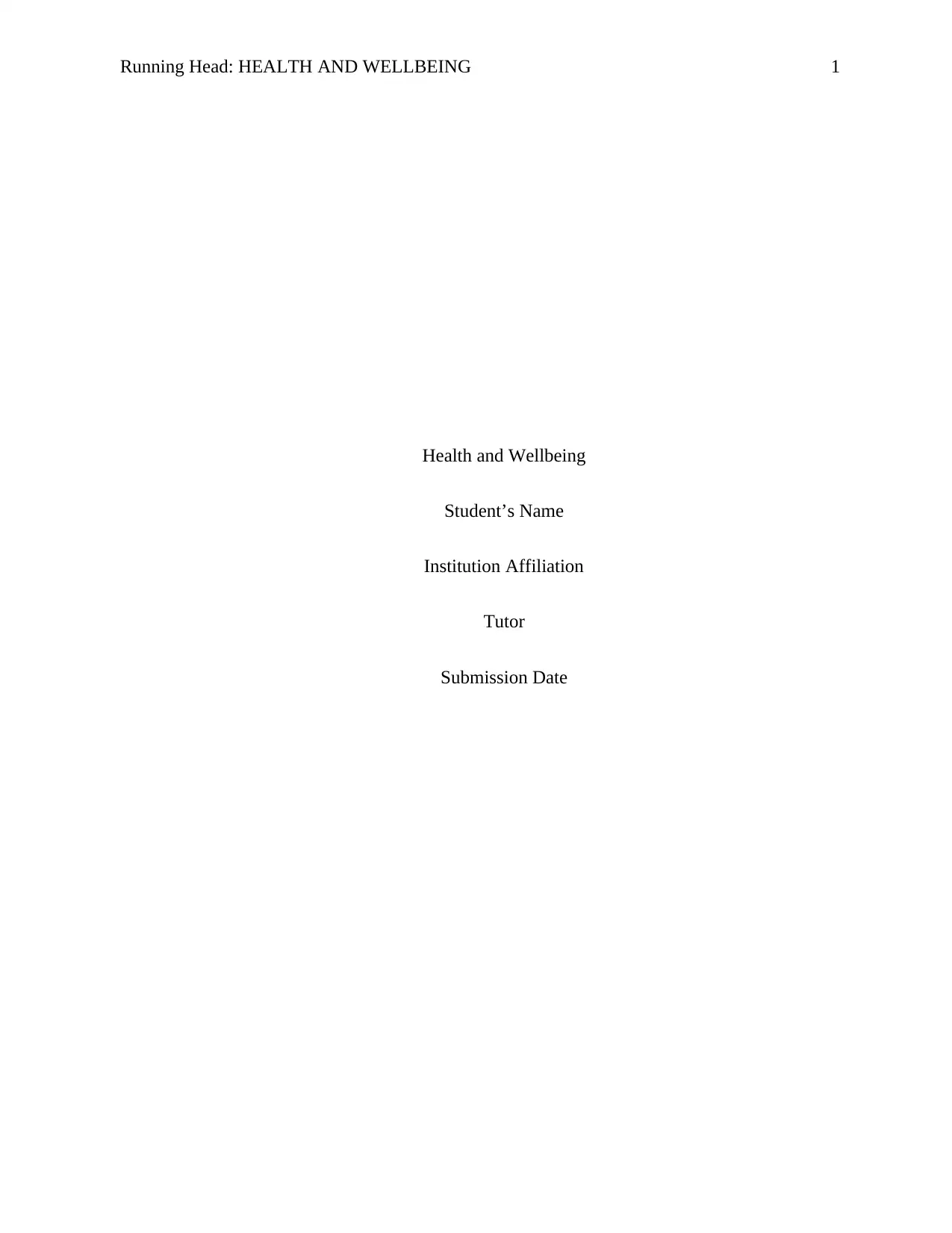
Running Head: HEALTH AND WELLBEING 1
Health and Wellbeing
Student’s Name
Institution Affiliation
Tutor
Submission Date
Health and Wellbeing
Student’s Name
Institution Affiliation
Tutor
Submission Date
Paraphrase This Document
Need a fresh take? Get an instant paraphrase of this document with our AI Paraphraser
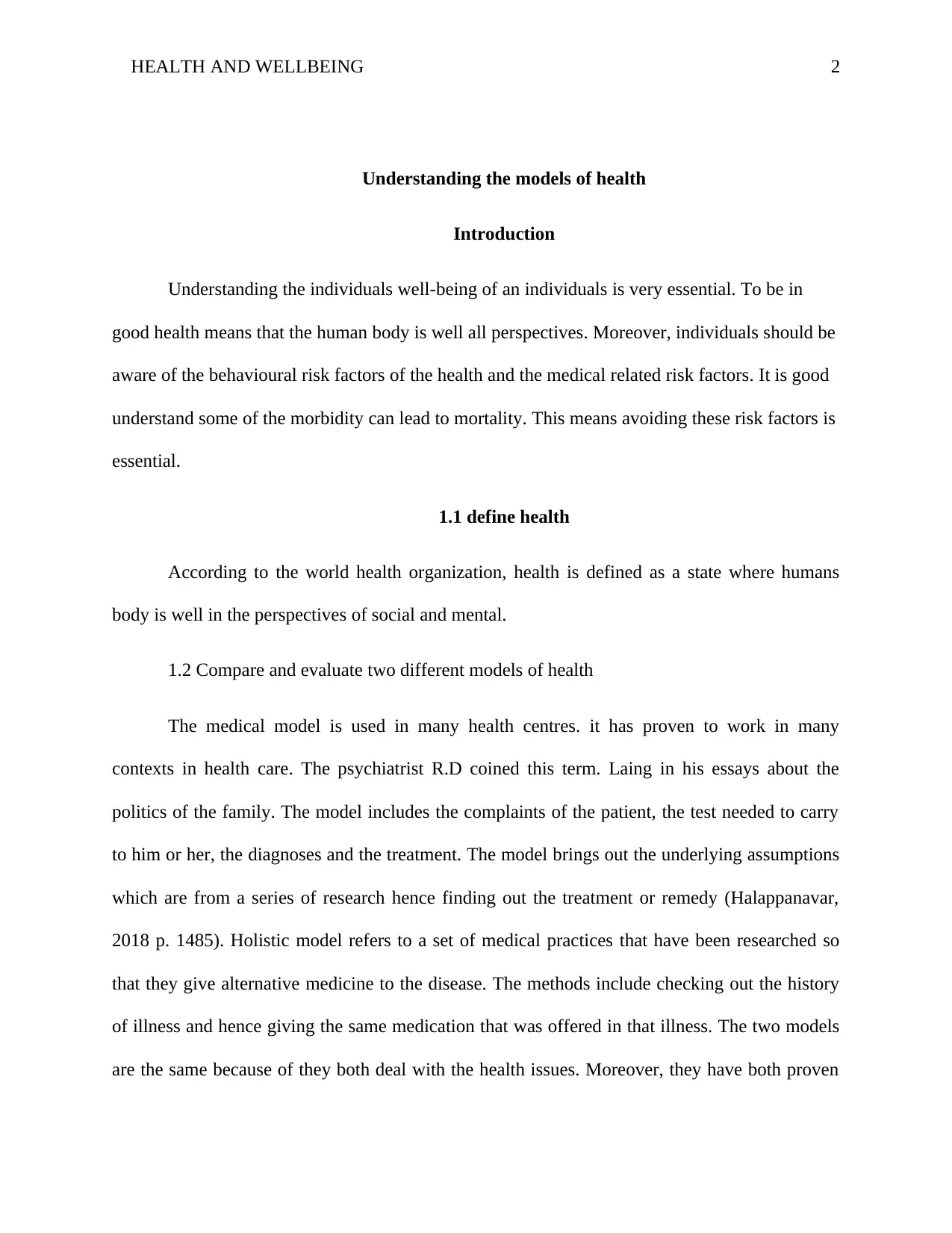
HEALTH AND WELLBEING 2
Understanding the models of health
Introduction
Understanding the individuals well-being of an individuals is very essential. To be in
good health means that the human body is well all perspectives. Moreover, individuals should be
aware of the behavioural risk factors of the health and the medical related risk factors. It is good
understand some of the morbidity can lead to mortality. This means avoiding these risk factors is
essential.
1.1 define health
According to the world health organization, health is defined as a state where humans
body is well in the perspectives of social and mental.
1.2 Compare and evaluate two different models of health
The medical model is used in many health centres. it has proven to work in many
contexts in health care. The psychiatrist R.D coined this term. Laing in his essays about the
politics of the family. The model includes the complaints of the patient, the test needed to carry
to him or her, the diagnoses and the treatment. The model brings out the underlying assumptions
which are from a series of research hence finding out the treatment or remedy (Halappanavar,
2018 p. 1485). Holistic model refers to a set of medical practices that have been researched so
that they give alternative medicine to the disease. The methods include checking out the history
of illness and hence giving the same medication that was offered in that illness. The two models
are the same because of they both deal with the health issues. Moreover, they have both proven
Understanding the models of health
Introduction
Understanding the individuals well-being of an individuals is very essential. To be in
good health means that the human body is well all perspectives. Moreover, individuals should be
aware of the behavioural risk factors of the health and the medical related risk factors. It is good
understand some of the morbidity can lead to mortality. This means avoiding these risk factors is
essential.
1.1 define health
According to the world health organization, health is defined as a state where humans
body is well in the perspectives of social and mental.
1.2 Compare and evaluate two different models of health
The medical model is used in many health centres. it has proven to work in many
contexts in health care. The psychiatrist R.D coined this term. Laing in his essays about the
politics of the family. The model includes the complaints of the patient, the test needed to carry
to him or her, the diagnoses and the treatment. The model brings out the underlying assumptions
which are from a series of research hence finding out the treatment or remedy (Halappanavar,
2018 p. 1485). Holistic model refers to a set of medical practices that have been researched so
that they give alternative medicine to the disease. The methods include checking out the history
of illness and hence giving the same medication that was offered in that illness. The two models
are the same because of they both deal with the health issues. Moreover, they have both proven
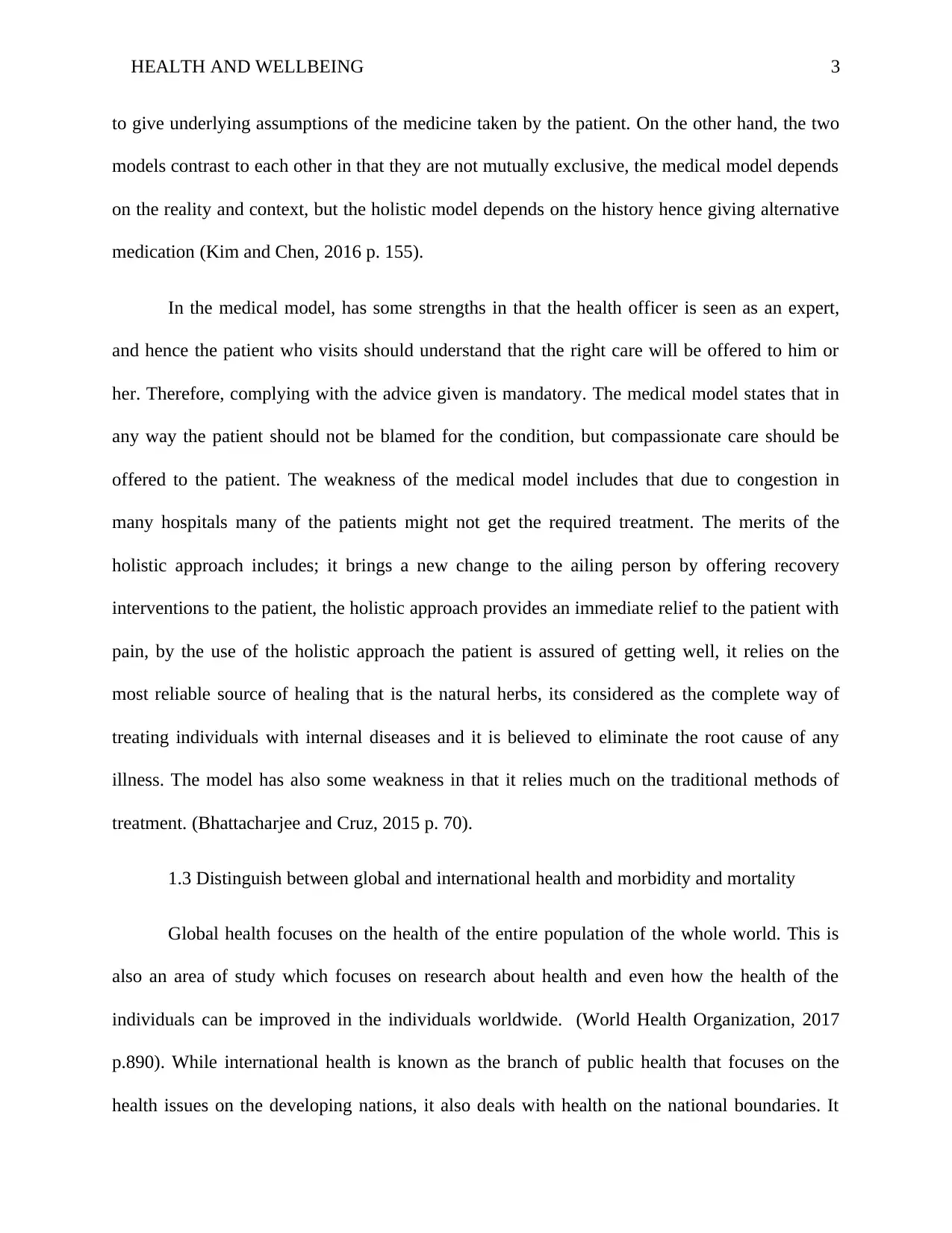
HEALTH AND WELLBEING 3
to give underlying assumptions of the medicine taken by the patient. On the other hand, the two
models contrast to each other in that they are not mutually exclusive, the medical model depends
on the reality and context, but the holistic model depends on the history hence giving alternative
medication (Kim and Chen, 2016 p. 155).
In the medical model, has some strengths in that the health officer is seen as an expert,
and hence the patient who visits should understand that the right care will be offered to him or
her. Therefore, complying with the advice given is mandatory. The medical model states that in
any way the patient should not be blamed for the condition, but compassionate care should be
offered to the patient. The weakness of the medical model includes that due to congestion in
many hospitals many of the patients might not get the required treatment. The merits of the
holistic approach includes; it brings a new change to the ailing person by offering recovery
interventions to the patient, the holistic approach provides an immediate relief to the patient with
pain, by the use of the holistic approach the patient is assured of getting well, it relies on the
most reliable source of healing that is the natural herbs, its considered as the complete way of
treating individuals with internal diseases and it is believed to eliminate the root cause of any
illness. The model has also some weakness in that it relies much on the traditional methods of
treatment. (Bhattacharjee and Cruz, 2015 p. 70).
1.3 Distinguish between global and international health and morbidity and mortality
Global health focuses on the health of the entire population of the whole world. This is
also an area of study which focuses on research about health and even how the health of the
individuals can be improved in the individuals worldwide. (World Health Organization, 2017
p.890). While international health is known as the branch of public health that focuses on the
health issues on the developing nations, it also deals with health on the national boundaries. It
to give underlying assumptions of the medicine taken by the patient. On the other hand, the two
models contrast to each other in that they are not mutually exclusive, the medical model depends
on the reality and context, but the holistic model depends on the history hence giving alternative
medication (Kim and Chen, 2016 p. 155).
In the medical model, has some strengths in that the health officer is seen as an expert,
and hence the patient who visits should understand that the right care will be offered to him or
her. Therefore, complying with the advice given is mandatory. The medical model states that in
any way the patient should not be blamed for the condition, but compassionate care should be
offered to the patient. The weakness of the medical model includes that due to congestion in
many hospitals many of the patients might not get the required treatment. The merits of the
holistic approach includes; it brings a new change to the ailing person by offering recovery
interventions to the patient, the holistic approach provides an immediate relief to the patient with
pain, by the use of the holistic approach the patient is assured of getting well, it relies on the
most reliable source of healing that is the natural herbs, its considered as the complete way of
treating individuals with internal diseases and it is believed to eliminate the root cause of any
illness. The model has also some weakness in that it relies much on the traditional methods of
treatment. (Bhattacharjee and Cruz, 2015 p. 70).
1.3 Distinguish between global and international health and morbidity and mortality
Global health focuses on the health of the entire population of the whole world. This is
also an area of study which focuses on research about health and even how the health of the
individuals can be improved in the individuals worldwide. (World Health Organization, 2017
p.890). While international health is known as the branch of public health that focuses on the
health issues on the developing nations, it also deals with health on the national boundaries. It
⊘ This is a preview!⊘
Do you want full access?
Subscribe today to unlock all pages.

Trusted by 1+ million students worldwide
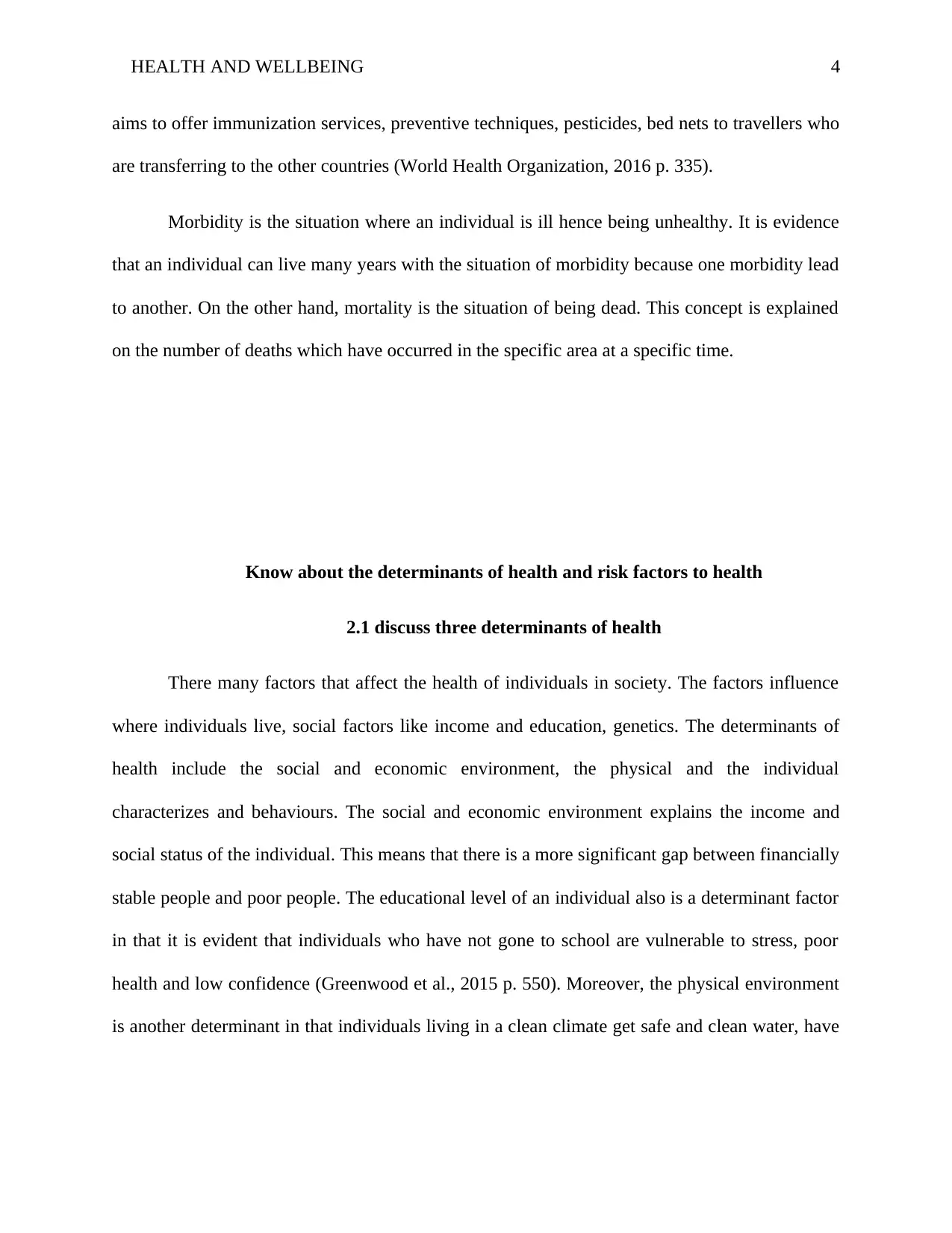
HEALTH AND WELLBEING 4
aims to offer immunization services, preventive techniques, pesticides, bed nets to travellers who
are transferring to the other countries (World Health Organization, 2016 p. 335).
Morbidity is the situation where an individual is ill hence being unhealthy. It is evidence
that an individual can live many years with the situation of morbidity because one morbidity lead
to another. On the other hand, mortality is the situation of being dead. This concept is explained
on the number of deaths which have occurred in the specific area at a specific time.
Know about the determinants of health and risk factors to health
2.1 discuss three determinants of health
There many factors that affect the health of individuals in society. The factors influence
where individuals live, social factors like income and education, genetics. The determinants of
health include the social and economic environment, the physical and the individual
characterizes and behaviours. The social and economic environment explains the income and
social status of the individual. This means that there is a more significant gap between financially
stable people and poor people. The educational level of an individual also is a determinant factor
in that it is evident that individuals who have not gone to school are vulnerable to stress, poor
health and low confidence (Greenwood et al., 2015 p. 550). Moreover, the physical environment
is another determinant in that individuals living in a clean climate get safe and clean water, have
aims to offer immunization services, preventive techniques, pesticides, bed nets to travellers who
are transferring to the other countries (World Health Organization, 2016 p. 335).
Morbidity is the situation where an individual is ill hence being unhealthy. It is evidence
that an individual can live many years with the situation of morbidity because one morbidity lead
to another. On the other hand, mortality is the situation of being dead. This concept is explained
on the number of deaths which have occurred in the specific area at a specific time.
Know about the determinants of health and risk factors to health
2.1 discuss three determinants of health
There many factors that affect the health of individuals in society. The factors influence
where individuals live, social factors like income and education, genetics. The determinants of
health include the social and economic environment, the physical and the individual
characterizes and behaviours. The social and economic environment explains the income and
social status of the individual. This means that there is a more significant gap between financially
stable people and poor people. The educational level of an individual also is a determinant factor
in that it is evident that individuals who have not gone to school are vulnerable to stress, poor
health and low confidence (Greenwood et al., 2015 p. 550). Moreover, the physical environment
is another determinant in that individuals living in a clean climate get safe and clean water, have
Paraphrase This Document
Need a fresh take? Get an instant paraphrase of this document with our AI Paraphraser
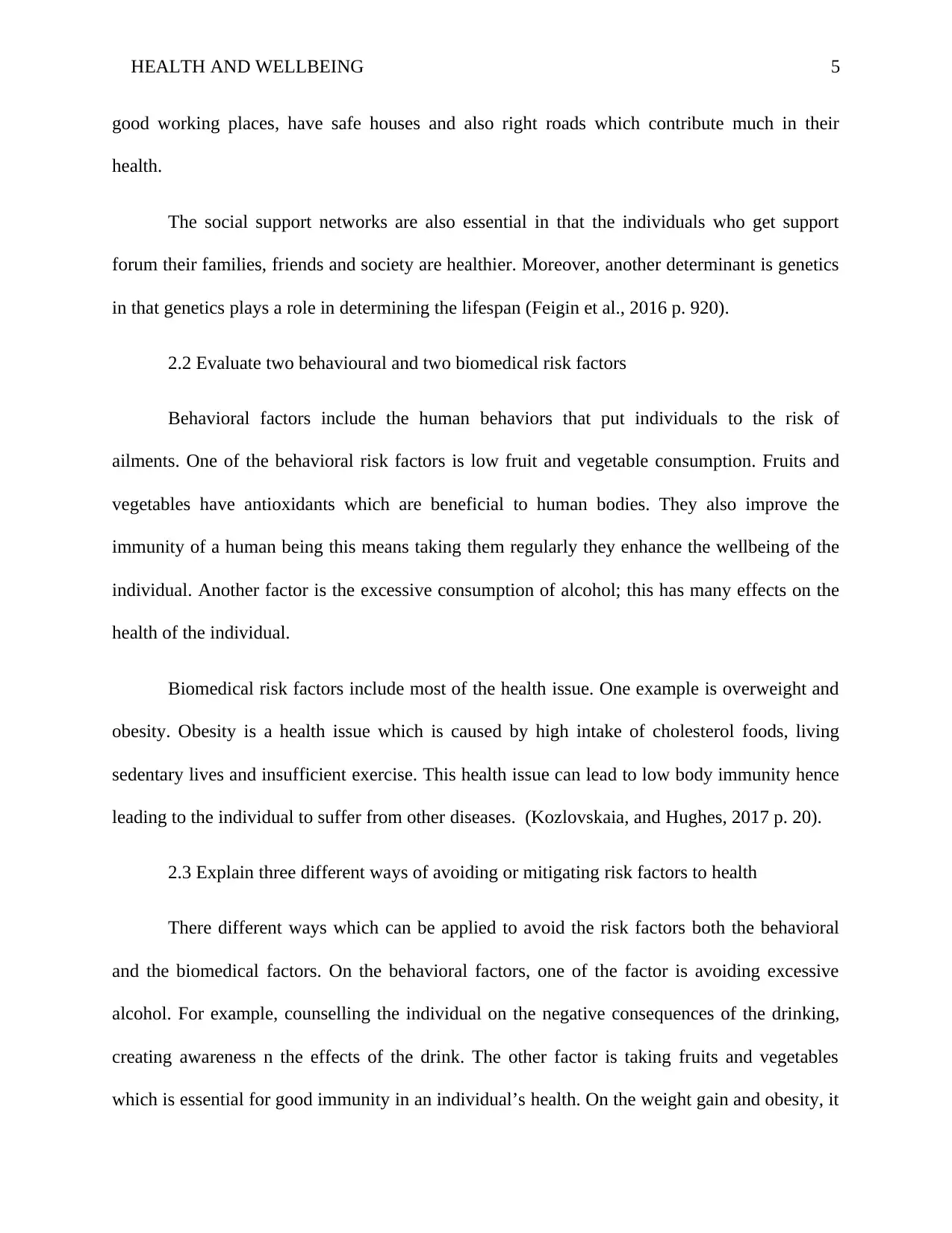
HEALTH AND WELLBEING 5
good working places, have safe houses and also right roads which contribute much in their
health.
The social support networks are also essential in that the individuals who get support
forum their families, friends and society are healthier. Moreover, another determinant is genetics
in that genetics plays a role in determining the lifespan (Feigin et al., 2016 p. 920).
2.2 Evaluate two behavioural and two biomedical risk factors
Behavioral factors include the human behaviors that put individuals to the risk of
ailments. One of the behavioral risk factors is low fruit and vegetable consumption. Fruits and
vegetables have antioxidants which are beneficial to human bodies. They also improve the
immunity of a human being this means taking them regularly they enhance the wellbeing of the
individual. Another factor is the excessive consumption of alcohol; this has many effects on the
health of the individual.
Biomedical risk factors include most of the health issue. One example is overweight and
obesity. Obesity is a health issue which is caused by high intake of cholesterol foods, living
sedentary lives and insufficient exercise. This health issue can lead to low body immunity hence
leading to the individual to suffer from other diseases. (Kozlovskaia, and Hughes, 2017 p. 20).
2.3 Explain three different ways of avoiding or mitigating risk factors to health
There different ways which can be applied to avoid the risk factors both the behavioral
and the biomedical factors. On the behavioral factors, one of the factor is avoiding excessive
alcohol. For example, counselling the individual on the negative consequences of the drinking,
creating awareness n the effects of the drink. The other factor is taking fruits and vegetables
which is essential for good immunity in an individual’s health. On the weight gain and obesity, it
good working places, have safe houses and also right roads which contribute much in their
health.
The social support networks are also essential in that the individuals who get support
forum their families, friends and society are healthier. Moreover, another determinant is genetics
in that genetics plays a role in determining the lifespan (Feigin et al., 2016 p. 920).
2.2 Evaluate two behavioural and two biomedical risk factors
Behavioral factors include the human behaviors that put individuals to the risk of
ailments. One of the behavioral risk factors is low fruit and vegetable consumption. Fruits and
vegetables have antioxidants which are beneficial to human bodies. They also improve the
immunity of a human being this means taking them regularly they enhance the wellbeing of the
individual. Another factor is the excessive consumption of alcohol; this has many effects on the
health of the individual.
Biomedical risk factors include most of the health issue. One example is overweight and
obesity. Obesity is a health issue which is caused by high intake of cholesterol foods, living
sedentary lives and insufficient exercise. This health issue can lead to low body immunity hence
leading to the individual to suffer from other diseases. (Kozlovskaia, and Hughes, 2017 p. 20).
2.3 Explain three different ways of avoiding or mitigating risk factors to health
There different ways which can be applied to avoid the risk factors both the behavioral
and the biomedical factors. On the behavioral factors, one of the factor is avoiding excessive
alcohol. For example, counselling the individual on the negative consequences of the drinking,
creating awareness n the effects of the drink. The other factor is taking fruits and vegetables
which is essential for good immunity in an individual’s health. On the weight gain and obesity, it
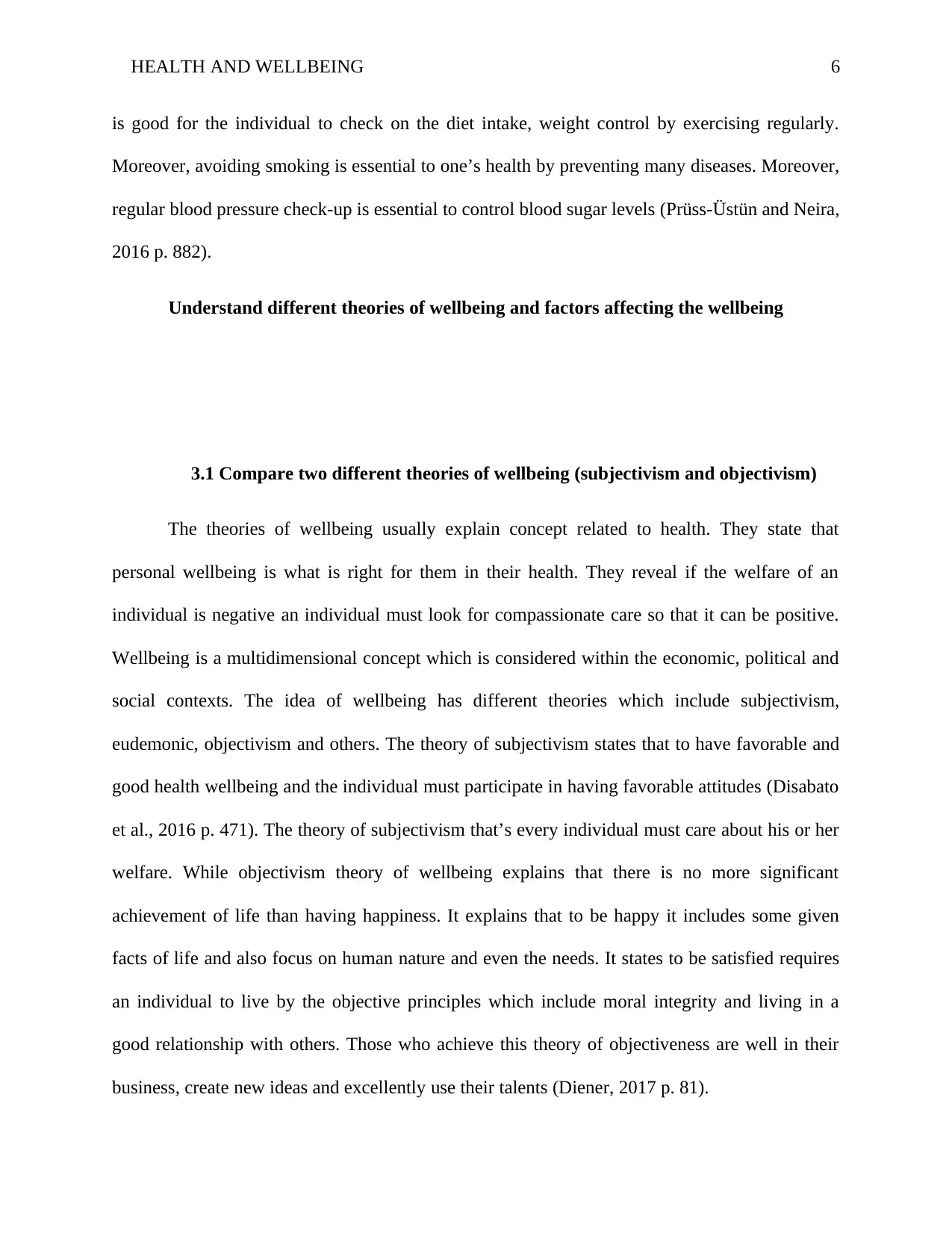
HEALTH AND WELLBEING 6
is good for the individual to check on the diet intake, weight control by exercising regularly.
Moreover, avoiding smoking is essential to one’s health by preventing many diseases. Moreover,
regular blood pressure check-up is essential to control blood sugar levels (Prüss-Üstün and Neira,
2016 p. 882).
Understand different theories of wellbeing and factors affecting the wellbeing
3.1 Compare two different theories of wellbeing (subjectivism and objectivism)
The theories of wellbeing usually explain concept related to health. They state that
personal wellbeing is what is right for them in their health. They reveal if the welfare of an
individual is negative an individual must look for compassionate care so that it can be positive.
Wellbeing is a multidimensional concept which is considered within the economic, political and
social contexts. The idea of wellbeing has different theories which include subjectivism,
eudemonic, objectivism and others. The theory of subjectivism states that to have favorable and
good health wellbeing and the individual must participate in having favorable attitudes (Disabato
et al., 2016 p. 471). The theory of subjectivism that’s every individual must care about his or her
welfare. While objectivism theory of wellbeing explains that there is no more significant
achievement of life than having happiness. It explains that to be happy it includes some given
facts of life and also focus on human nature and even the needs. It states to be satisfied requires
an individual to live by the objective principles which include moral integrity and living in a
good relationship with others. Those who achieve this theory of objectiveness are well in their
business, create new ideas and excellently use their talents (Diener, 2017 p. 81).
is good for the individual to check on the diet intake, weight control by exercising regularly.
Moreover, avoiding smoking is essential to one’s health by preventing many diseases. Moreover,
regular blood pressure check-up is essential to control blood sugar levels (Prüss-Üstün and Neira,
2016 p. 882).
Understand different theories of wellbeing and factors affecting the wellbeing
3.1 Compare two different theories of wellbeing (subjectivism and objectivism)
The theories of wellbeing usually explain concept related to health. They state that
personal wellbeing is what is right for them in their health. They reveal if the welfare of an
individual is negative an individual must look for compassionate care so that it can be positive.
Wellbeing is a multidimensional concept which is considered within the economic, political and
social contexts. The idea of wellbeing has different theories which include subjectivism,
eudemonic, objectivism and others. The theory of subjectivism states that to have favorable and
good health wellbeing and the individual must participate in having favorable attitudes (Disabato
et al., 2016 p. 471). The theory of subjectivism that’s every individual must care about his or her
welfare. While objectivism theory of wellbeing explains that there is no more significant
achievement of life than having happiness. It explains that to be happy it includes some given
facts of life and also focus on human nature and even the needs. It states to be satisfied requires
an individual to live by the objective principles which include moral integrity and living in a
good relationship with others. Those who achieve this theory of objectiveness are well in their
business, create new ideas and excellently use their talents (Diener, 2017 p. 81).
⊘ This is a preview!⊘
Do you want full access?
Subscribe today to unlock all pages.

Trusted by 1+ million students worldwide
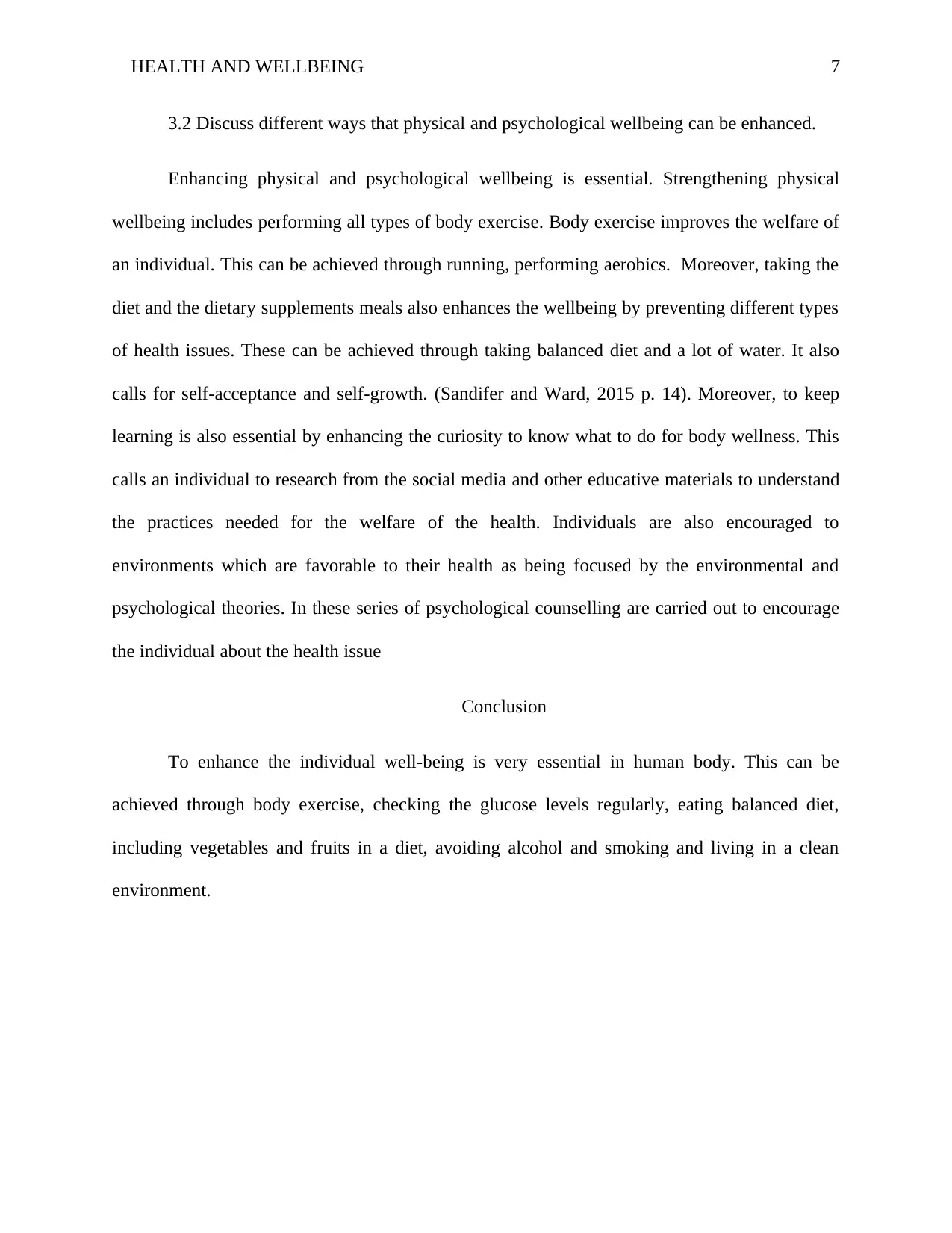
HEALTH AND WELLBEING 7
3.2 Discuss different ways that physical and psychological wellbeing can be enhanced.
Enhancing physical and psychological wellbeing is essential. Strengthening physical
wellbeing includes performing all types of body exercise. Body exercise improves the welfare of
an individual. This can be achieved through running, performing aerobics. Moreover, taking the
diet and the dietary supplements meals also enhances the wellbeing by preventing different types
of health issues. These can be achieved through taking balanced diet and a lot of water. It also
calls for self-acceptance and self-growth. (Sandifer and Ward, 2015 p. 14). Moreover, to keep
learning is also essential by enhancing the curiosity to know what to do for body wellness. This
calls an individual to research from the social media and other educative materials to understand
the practices needed for the welfare of the health. Individuals are also encouraged to
environments which are favorable to their health as being focused by the environmental and
psychological theories. In these series of psychological counselling are carried out to encourage
the individual about the health issue
Conclusion
To enhance the individual well-being is very essential in human body. This can be
achieved through body exercise, checking the glucose levels regularly, eating balanced diet,
including vegetables and fruits in a diet, avoiding alcohol and smoking and living in a clean
environment.
3.2 Discuss different ways that physical and psychological wellbeing can be enhanced.
Enhancing physical and psychological wellbeing is essential. Strengthening physical
wellbeing includes performing all types of body exercise. Body exercise improves the welfare of
an individual. This can be achieved through running, performing aerobics. Moreover, taking the
diet and the dietary supplements meals also enhances the wellbeing by preventing different types
of health issues. These can be achieved through taking balanced diet and a lot of water. It also
calls for self-acceptance and self-growth. (Sandifer and Ward, 2015 p. 14). Moreover, to keep
learning is also essential by enhancing the curiosity to know what to do for body wellness. This
calls an individual to research from the social media and other educative materials to understand
the practices needed for the welfare of the health. Individuals are also encouraged to
environments which are favorable to their health as being focused by the environmental and
psychological theories. In these series of psychological counselling are carried out to encourage
the individual about the health issue
Conclusion
To enhance the individual well-being is very essential in human body. This can be
achieved through body exercise, checking the glucose levels regularly, eating balanced diet,
including vegetables and fruits in a diet, avoiding alcohol and smoking and living in a clean
environment.
Paraphrase This Document
Need a fresh take? Get an instant paraphrase of this document with our AI Paraphraser
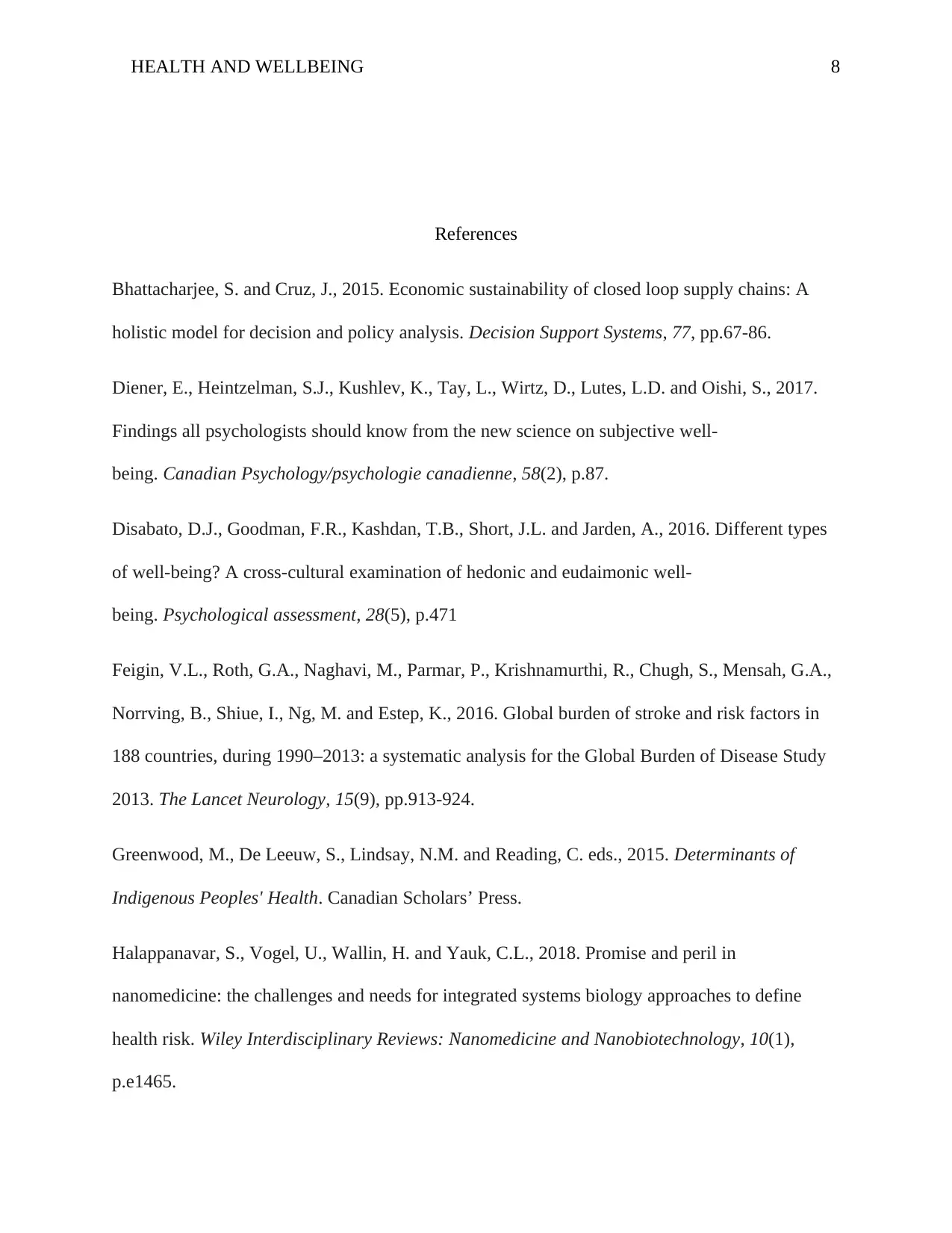
HEALTH AND WELLBEING 8
References
Bhattacharjee, S. and Cruz, J., 2015. Economic sustainability of closed loop supply chains: A
holistic model for decision and policy analysis. Decision Support Systems, 77, pp.67-86.
Diener, E., Heintzelman, S.J., Kushlev, K., Tay, L., Wirtz, D., Lutes, L.D. and Oishi, S., 2017.
Findings all psychologists should know from the new science on subjective well-
being. Canadian Psychology/psychologie canadienne, 58(2), p.87.
Disabato, D.J., Goodman, F.R., Kashdan, T.B., Short, J.L. and Jarden, A., 2016. Different types
of well-being? A cross-cultural examination of hedonic and eudaimonic well-
being. Psychological assessment, 28(5), p.471
Feigin, V.L., Roth, G.A., Naghavi, M., Parmar, P., Krishnamurthi, R., Chugh, S., Mensah, G.A.,
Norrving, B., Shiue, I., Ng, M. and Estep, K., 2016. Global burden of stroke and risk factors in
188 countries, during 1990–2013: a systematic analysis for the Global Burden of Disease Study
2013. The Lancet Neurology, 15(9), pp.913-924.
Greenwood, M., De Leeuw, S., Lindsay, N.M. and Reading, C. eds., 2015. Determinants of
Indigenous Peoples' Health. Canadian Scholars’ Press.
Halappanavar, S., Vogel, U., Wallin, H. and Yauk, C.L., 2018. Promise and peril in
nanomedicine: the challenges and needs for integrated systems biology approaches to define
health risk. Wiley Interdisciplinary Reviews: Nanomedicine and Nanobiotechnology, 10(1),
p.e1465.
References
Bhattacharjee, S. and Cruz, J., 2015. Economic sustainability of closed loop supply chains: A
holistic model for decision and policy analysis. Decision Support Systems, 77, pp.67-86.
Diener, E., Heintzelman, S.J., Kushlev, K., Tay, L., Wirtz, D., Lutes, L.D. and Oishi, S., 2017.
Findings all psychologists should know from the new science on subjective well-
being. Canadian Psychology/psychologie canadienne, 58(2), p.87.
Disabato, D.J., Goodman, F.R., Kashdan, T.B., Short, J.L. and Jarden, A., 2016. Different types
of well-being? A cross-cultural examination of hedonic and eudaimonic well-
being. Psychological assessment, 28(5), p.471
Feigin, V.L., Roth, G.A., Naghavi, M., Parmar, P., Krishnamurthi, R., Chugh, S., Mensah, G.A.,
Norrving, B., Shiue, I., Ng, M. and Estep, K., 2016. Global burden of stroke and risk factors in
188 countries, during 1990–2013: a systematic analysis for the Global Burden of Disease Study
2013. The Lancet Neurology, 15(9), pp.913-924.
Greenwood, M., De Leeuw, S., Lindsay, N.M. and Reading, C. eds., 2015. Determinants of
Indigenous Peoples' Health. Canadian Scholars’ Press.
Halappanavar, S., Vogel, U., Wallin, H. and Yauk, C.L., 2018. Promise and peril in
nanomedicine: the challenges and needs for integrated systems biology approaches to define
health risk. Wiley Interdisciplinary Reviews: Nanomedicine and Nanobiotechnology, 10(1),
p.e1465.
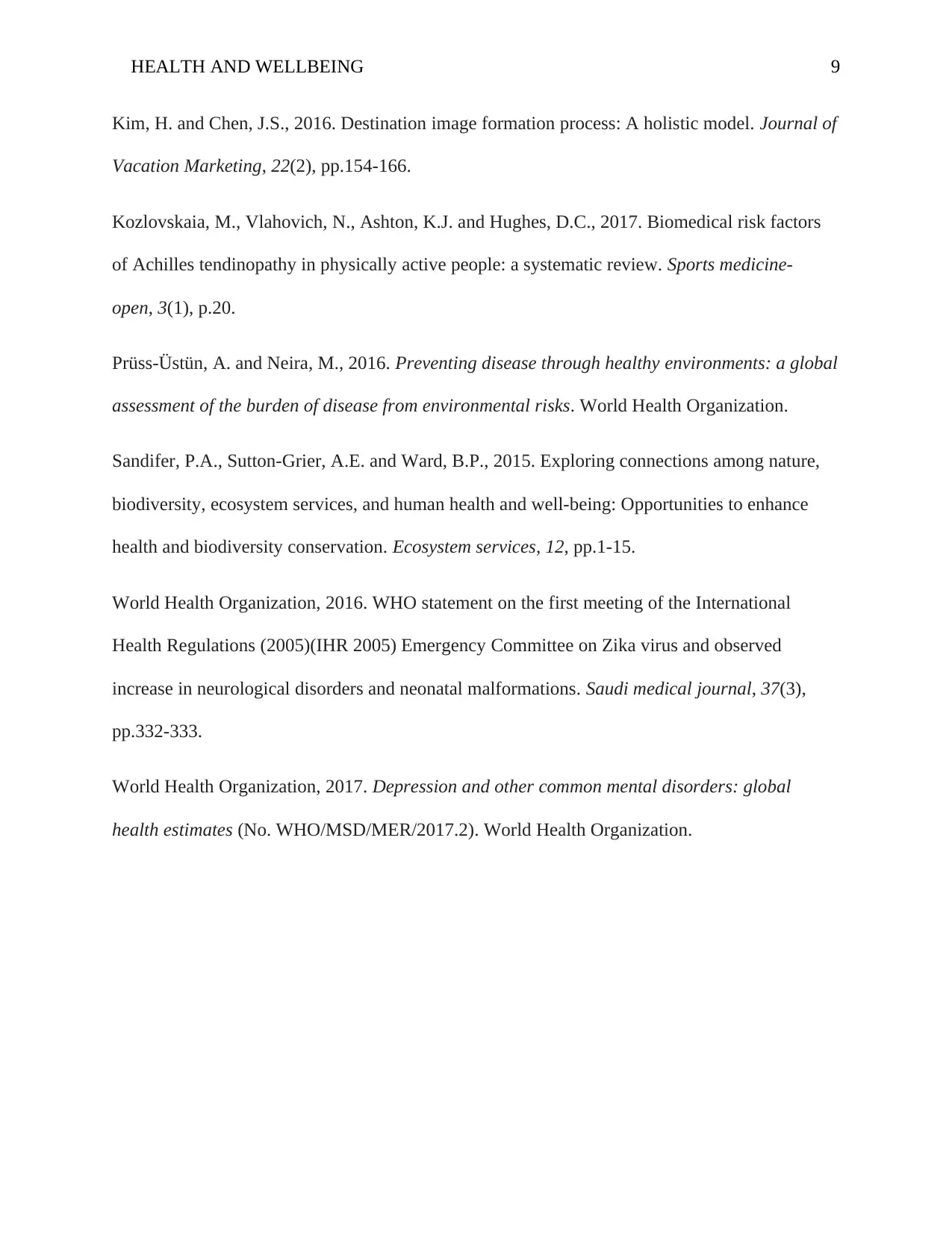
HEALTH AND WELLBEING 9
Kim, H. and Chen, J.S., 2016. Destination image formation process: A holistic model. Journal of
Vacation Marketing, 22(2), pp.154-166.
Kozlovskaia, M., Vlahovich, N., Ashton, K.J. and Hughes, D.C., 2017. Biomedical risk factors
of Achilles tendinopathy in physically active people: a systematic review. Sports medicine-
open, 3(1), p.20.
Prüss-Üstün, A. and Neira, M., 2016. Preventing disease through healthy environments: a global
assessment of the burden of disease from environmental risks. World Health Organization.
Sandifer, P.A., Sutton-Grier, A.E. and Ward, B.P., 2015. Exploring connections among nature,
biodiversity, ecosystem services, and human health and well-being: Opportunities to enhance
health and biodiversity conservation. Ecosystem services, 12, pp.1-15.
World Health Organization, 2016. WHO statement on the first meeting of the International
Health Regulations (2005)(IHR 2005) Emergency Committee on Zika virus and observed
increase in neurological disorders and neonatal malformations. Saudi medical journal, 37(3),
pp.332-333.
World Health Organization, 2017. Depression and other common mental disorders: global
health estimates (No. WHO/MSD/MER/2017.2). World Health Organization.
Kim, H. and Chen, J.S., 2016. Destination image formation process: A holistic model. Journal of
Vacation Marketing, 22(2), pp.154-166.
Kozlovskaia, M., Vlahovich, N., Ashton, K.J. and Hughes, D.C., 2017. Biomedical risk factors
of Achilles tendinopathy in physically active people: a systematic review. Sports medicine-
open, 3(1), p.20.
Prüss-Üstün, A. and Neira, M., 2016. Preventing disease through healthy environments: a global
assessment of the burden of disease from environmental risks. World Health Organization.
Sandifer, P.A., Sutton-Grier, A.E. and Ward, B.P., 2015. Exploring connections among nature,
biodiversity, ecosystem services, and human health and well-being: Opportunities to enhance
health and biodiversity conservation. Ecosystem services, 12, pp.1-15.
World Health Organization, 2016. WHO statement on the first meeting of the International
Health Regulations (2005)(IHR 2005) Emergency Committee on Zika virus and observed
increase in neurological disorders and neonatal malformations. Saudi medical journal, 37(3),
pp.332-333.
World Health Organization, 2017. Depression and other common mental disorders: global
health estimates (No. WHO/MSD/MER/2017.2). World Health Organization.
⊘ This is a preview!⊘
Do you want full access?
Subscribe today to unlock all pages.

Trusted by 1+ million students worldwide
1 out of 9
Related Documents
Your All-in-One AI-Powered Toolkit for Academic Success.
+13062052269
info@desklib.com
Available 24*7 on WhatsApp / Email
![[object Object]](/_next/static/media/star-bottom.7253800d.svg)
Unlock your academic potential
Copyright © 2020–2025 A2Z Services. All Rights Reserved. Developed and managed by ZUCOL.





